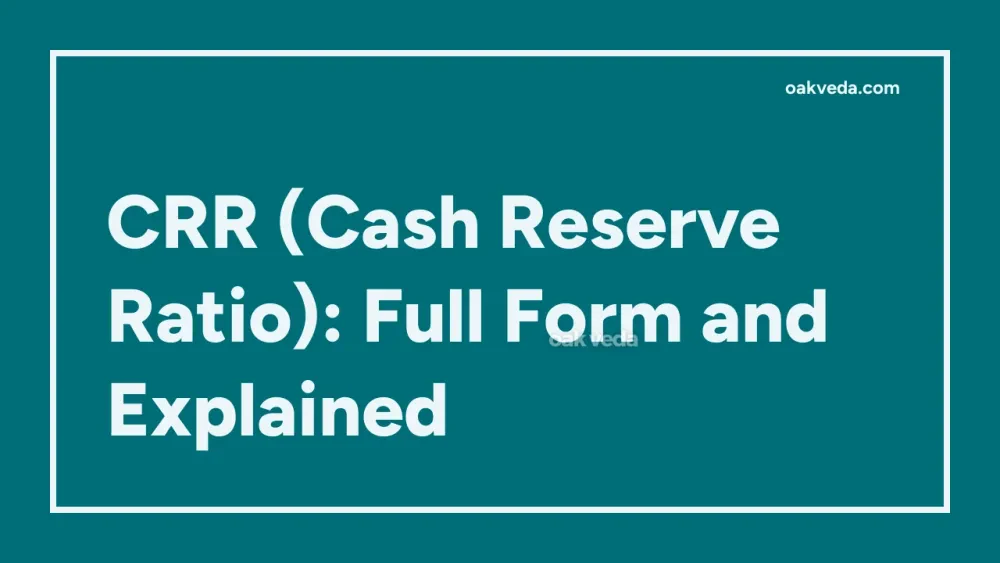
What is the Full Form of CRR?
The full form of CRR is Cash Reserve Ratio. This term is widely used in the banking and financial sector, particularly in India. CRR plays a crucial role in monetary policy and financial regulation, impacting the overall economy.
What is Cash Reserve Ratio?
Cash Reserve Ratio refers to the minimum percentage of total deposits that commercial banks are required to maintain as liquid cash reserves with the central bank. In India, the Reserve Bank of India (RBI) sets and regulates the CRR. This ratio ensures that banks have sufficient liquidity to meet customer withdrawal demands and helps the central bank control the money supply in the economy.
Origin and Development of Cash Reserve Ratio
The concept of Cash Reserve Ratio has its roots in the early days of modern banking. As banking systems evolved, central banks recognized the need for a mechanism to ensure bank stability and control money supply. In India, the CRR was introduced as part of the RBI Act, 1934, and has since been an essential tool for monetary policy implementation.
How does Cash Reserve Ratio work?
The Cash Reserve Ratio works as follows:
- The RBI sets the CRR percentage.
- Banks calculate the required reserve based on their Net Demand and Time Liabilities (NDTL).
- Banks maintain the calculated amount with the RBI.
- This reserve cannot be used for lending or investment purposes.
For example, if the CRR is set at 4% and a bank has total deposits of ₹1,000 crore, it must maintain ₹40 crore as a cash reserve with the RBI.
Functions of Cash Reserve Ratio
The Cash Reserve Ratio serves several important functions:
- Liquidity Management: Ensures banks have sufficient cash to meet customer demands.
- Monetary Policy Tool: Helps the RBI control money supply and inflation.
- Financial Stability: Acts as a safeguard against bank runs and financial crises.
- Credit Control: Influences banks' lending capacity and overall credit growth.
Applications of Cash Reserve Ratio
The Cash Reserve Ratio has wide-ranging applications in the financial system:
- Inflation Control: By adjusting the CRR, the RBI can influence money supply and combat inflation.
- Economic Growth Regulation: CRR changes can stimulate or slow down economic growth by affecting credit availability.
- Banking Sector Stability: Ensures a minimum level of liquidity in the banking system.
- Monetary Policy Transmission: Helps in effectively implementing monetary policy decisions.
Features of Cash Reserve Ratio
Key features of the Cash Reserve Ratio include:
- Mandatory Requirement: All scheduled commercial banks must maintain the prescribed CRR.
- No Interest: The RBI does not pay interest on CRR balances.
- Daily Maintenance: Banks must maintain the required CRR on a daily basis.
- Penalty for Non-Compliance: Banks face penalties for failing to maintain the required CRR.
Benefits of Cash Reserve Ratio
The Cash Reserve Ratio offers several benefits to the financial system:
- Financial Stability: Helps maintain confidence in the banking system.
- Inflation Control: Assists in managing inflation by regulating money supply.
- Liquidity Assurance: Ensures banks have sufficient funds to meet customer demands.
- Monetary Policy Effectiveness: Enhances the central bank's ability to implement monetary policies.
Limitations or Challenges of Cash Reserve Ratio
Despite its benefits, the Cash Reserve Ratio also has some limitations:
- Opportunity Cost: Banks lose potential earnings on funds held as CRR.
- Reduced Lending Capacity: Higher CRR reduces banks' ability to lend and earn interest.
- Complexity: Frequent changes in CRR can create operational challenges for banks.
- Limited Effectiveness: In certain economic conditions, CRR changes may have limited impact.
Future Developments in Cash Reserve Ratio
As the financial landscape evolves, the role and implementation of Cash Reserve Ratio may see some changes:
- Digital Currencies: The introduction of Central Bank Digital Currencies (CBDCs) may impact how CRR is calculated and maintained.
- Fintech Integration: Advanced technologies may allow for more dynamic and real-time CRR management.
- Global Harmonization: There may be efforts to harmonize reserve requirements across countries to enhance global financial stability.
- Alternative Tools: Central banks might explore new monetary policy tools to complement or partially replace CRR.
FAQs on CRR Full Form
-
What is the current CRR rate in India? As of 2023, the CRR rate set by the RBI is 4.5% of NDTL.
-
How often does the RBI change the CRR? The RBI reviews and adjusts the CRR periodically, typically during its monetary policy meetings.
-
Does CRR apply to all types of banks? CRR is mandatory for all scheduled commercial banks in India.
-
Can banks use CRR funds for lending? No, banks cannot use CRR funds for lending or investment purposes.
-
How does CRR differ from Statutory Liquidity Ratio (SLR)? While CRR must be maintained in cash, SLR can be maintained in the form of approved securities.
Understanding the full form and implications of CRR is crucial for anyone interested in banking, finance, or economics. As a key monetary policy tool, the Cash Reserve Ratio continues to play a vital role in shaping India's financial landscape and economic stability.
You may be interested in:

